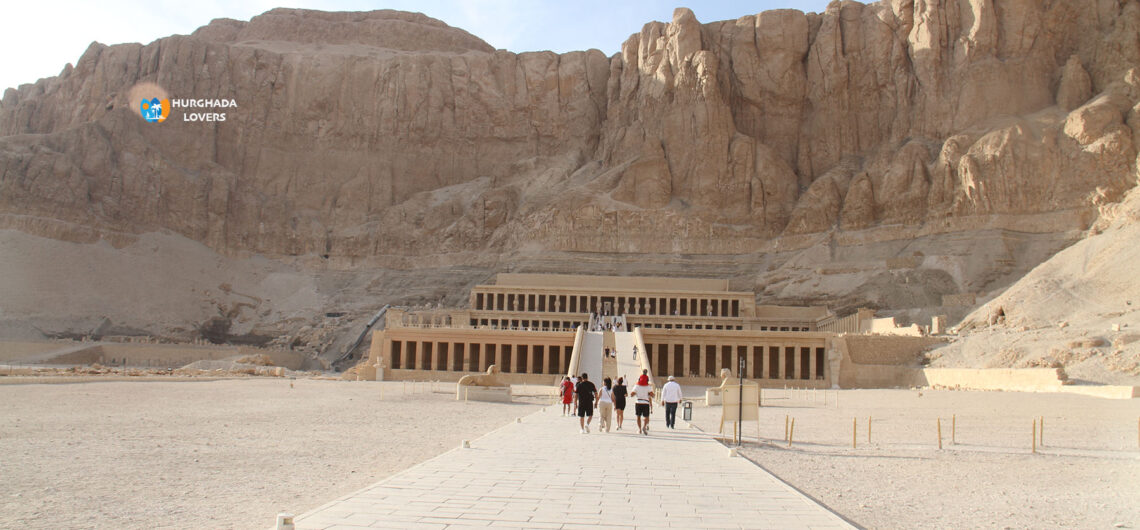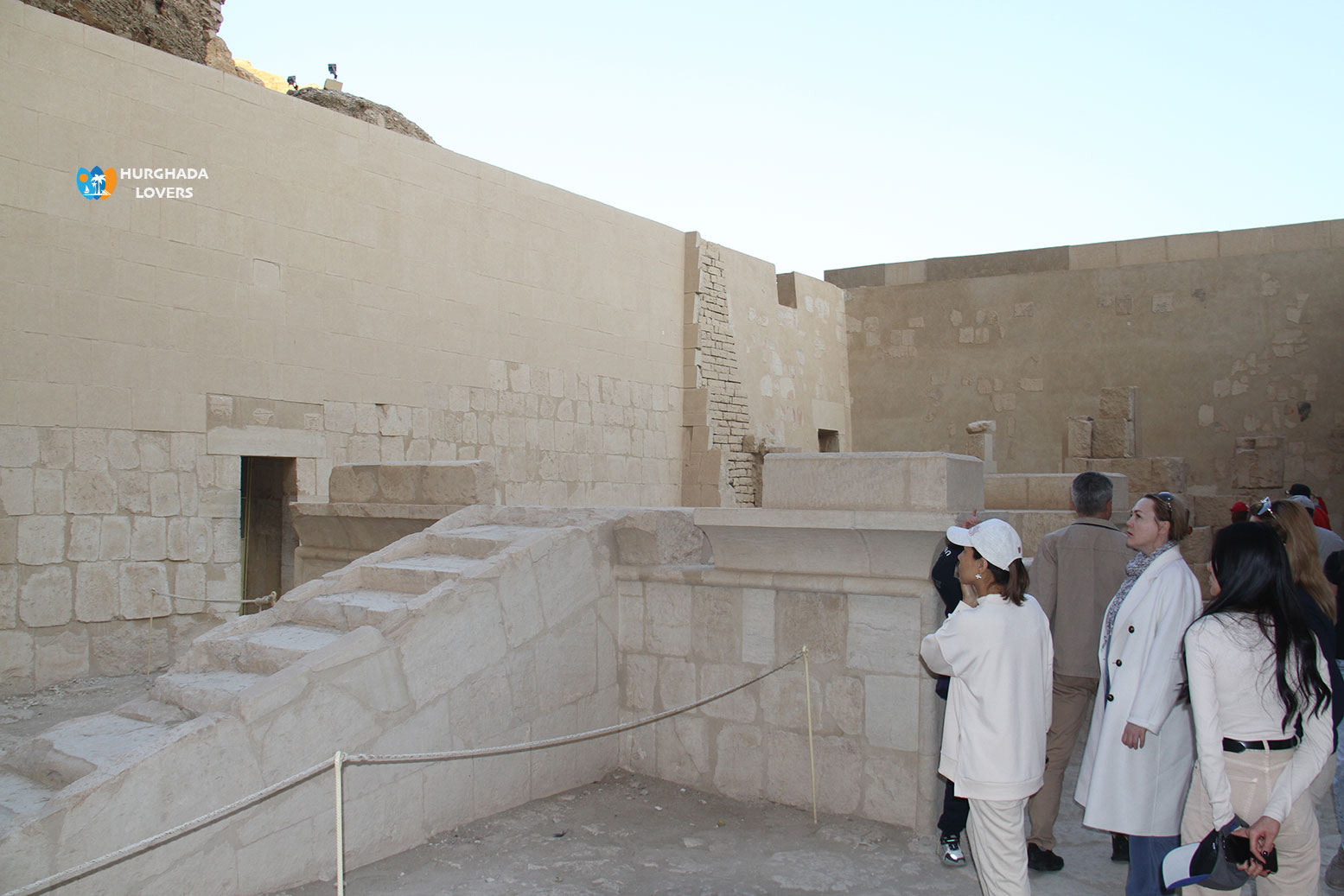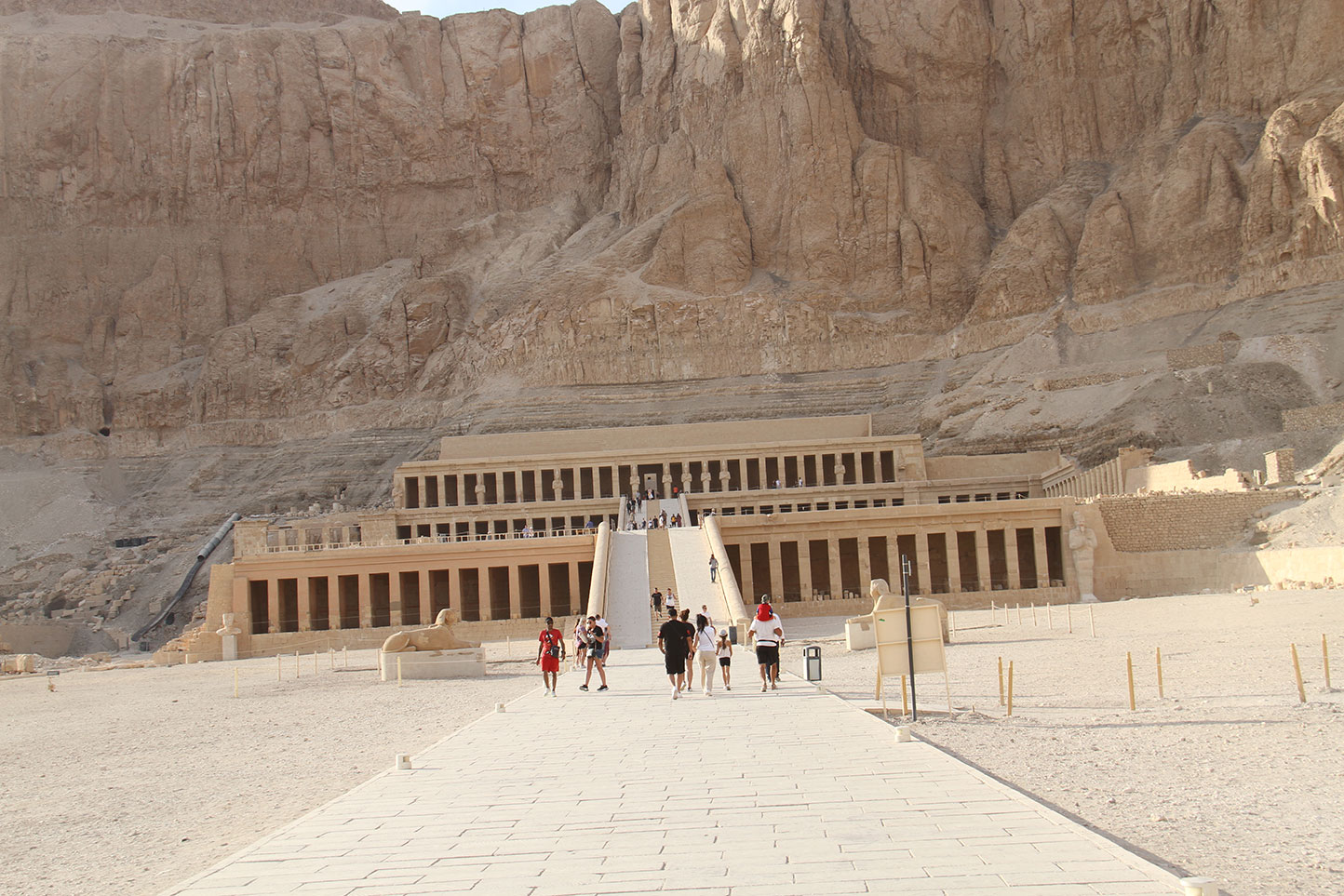Temple of Hatshepsut in Luxor, Egypt – Egyptian Temples
Historical facts about the most famous Egyptian funerary Mortuary Temples, discover the secret of Queen Hatshepsut construction in the Ancient Egypt civilization and what are the details of the architectural design and how to reach it and more.
Discover The secret of building the Temple of Queen Hatshepsut, The most famous “Female Pharaohs” Egyptian Pharaonic queens from the Eighteenth Dynasty of Egypt in the era of The New Kingdom of Egypt.
Discover What are the inner chambers that were discovered and the drawings and engravings of the Pharaohs and What are the visiting hours and entrance ticket prices and the most important Egyptian Pharaohs kings who influenced and participated in the construction of the Temple of Hatshepsut and more to start visiting the tourist attractions in Luxor.
Discover the facts of Sculpture in Ancient Egypt, the history of Architecture in ancient Egypt and the secrets of building the most important funerary temples and Pharaonic Egyptian Monuments in the archaeological city of Thebes.
Temple of Hatshepsut Facts
Opening date: November 1997
Temple type: Funerary temple
Pharaonic Dynasty: Eighteenth
Age of the temple: 3500 years
Location: West Bank of the Nile River.
Temple construction period: 15 years
Secrets of building Hatshepsut Temple in Luxor:
In the rocky hills of Deir El Bahari, part of it was dedicated to the worship of the God Amun, the most famous of the ancient Egyptian deities – Ancient Egyptian gods and Goddesses, and the religious beliefs and Ancient Egyptian religion among the Pharaohs.
The architectural design is considered one of the most wonderful things that the Egyptian artist did in the art of architecture in ancient Egypt.
It was built by the engineer and minister Senenmut, the most famous of the Egyptian Pharaohs, and he may have been inspired by the The Tomb of Amenhotep III | KV22 / WV22 in the Valley of the Kings, which was built in the era of King Amenhotep III, which is specific to the New Kingdom period in ancient Egypt. It reveals to us the secrets of Egyptian Tombs and architecture in ancient Egypt..
Temple of Hatshepsut consists of three levels at different levels, and these levels are connected to each other by an ascending path that ends at the next surface, and on both sides of the path are elevators and two porticoes with columns. The last surface ends with the body of the mountain in which the room of the god was carved, known as the Holy of Holies in the beliefs of the ancient Egyptian civilization..
In Deir el-Bahari, one of the most famous Egypt Archaeological Sites, learn about the history of the construction of the most important ancient Egyptian Pharaonic funerary temples located in the city of Luxor, which contains most of the Egyptian Antiquities and secrets of the Pharaohs that you did not know..
Queen Hatshepsut is considered one of the most famous queens of ancient Egyptian civilization. She is the only woman who ruled in ancient Egypt “Ancient Egyptian Government” in the Pharaonic era as a pharaoh like a male king and received the official royal Coronation of the Pharaohs.
The word Hat means introduction or first, the word Shepsut means the nobles, that is, the best of the nobles, and the name was chosen by the High Priest of Amun after consulting with her mother, Queen Ahmose, the wife of King Thutmose I.
In addition, the temple of Hatshepsut was named “Djeser Djesero” which means the greatest of the greats..
Queen Hatshepsut was interested in building the temple and transferring all her belongings to the temple as a destination and place for the “god Amun” as it was an ancient belief in the funerary beliefs in ancient Egypt.
She established other places for other goddesses where the shrines of the God Hathor and the God Anubis were found to make it a funerary temple for her and her family, King Thutmose I and her mother, Queen Ahmose..
Egyptology explained that the reason for Queen Hatshepsut building the temple was to confirm to the members of the royal family her right to the throne, as there were conflicts and disputes over her right to the throne of Egypt in the Eighteenth Egyptian Dynasty that ruled Egypt at that time, to reveal to us facts about how Social Structure in Ancient Egypt and the Revolutions in Ancient Egypt.
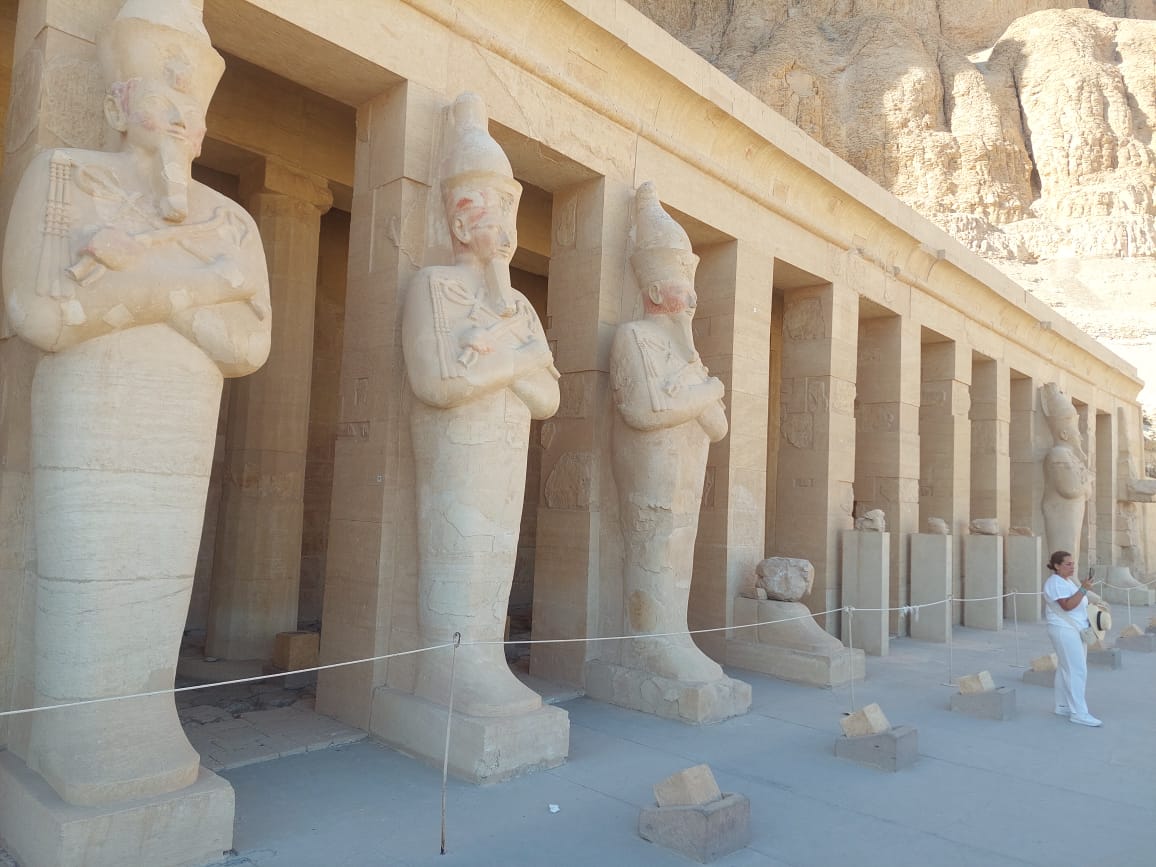
Temple of Hatshepsut Interior Design
The ancient Temple of Hatshepsut was different from the current situation, as many of the monuments were destroyed due to the passage of time, erosion and climate.
You could reach the temple by means of rams in the Karnak Temple complex from the valley through a large gate, in front of which were two spruce trees inside a very luxurious fence..
The ancient Egyptians considered this type of tree sacred in religious beliefs in ancient Egypt, as this was discovered through the papyrus of the story of the brothers Anubis and Bata “the most famous Ancient Egyptian Papyrus” within the stories of Ancient Egyptian Literature and the legends of the pharaohs “Egyptian Mythology” in the hieratic language, one of the languages of the Ancient Egyptian Language, and it was circulated among people in the Pharaonic era..
When exiting the large gate, there was a large group of palm trees and ancient Egyptian papyrus plants, but they were largely destroyed, but there are still some remains of them as relics until now..
On the western side of the courtyard, you will find iwans roofed on two rows of huge columns. You will find that the iwan on the northern side has greatly deteriorated, with remains of a scene and Pharaonic engravings of hunting birds, while the iwan on the southern side, the “Iwan of Punt,” contains clear Pharaonic engravings to this day, revealing more about the art of drawing in ancient Egypt and Agriculture in Ancient Egypt.
We find that there are 22 square columns in the courtyard, in addition to 4 columns next to the northern Iwan (the Iwan of Birth), where engravings of the birth stage were drawn with high precision by artists in the Pharaonic era to reveal to us the secrets of sculpture in ancient Egypt..
When you then head south from the direction of the Iwan of Punt, you will find the Temple of Hathor opposite the Temple of Anuis located at the end of the Iwan of Birth, which you could reach via a separate and sloping path..
You will find that there is a hall of two separate halls, where you will find in the first hall 4 square columns with Hathoric capitals, behind them two rows of columns, consisting of 18 sides and 4 square columns..
In the second hall you will find 3 round columns with Hathor capitals and 16-sided columns in addition to Pharaonic drawings and engravings on the wall on both sides of the inner section of the hall..
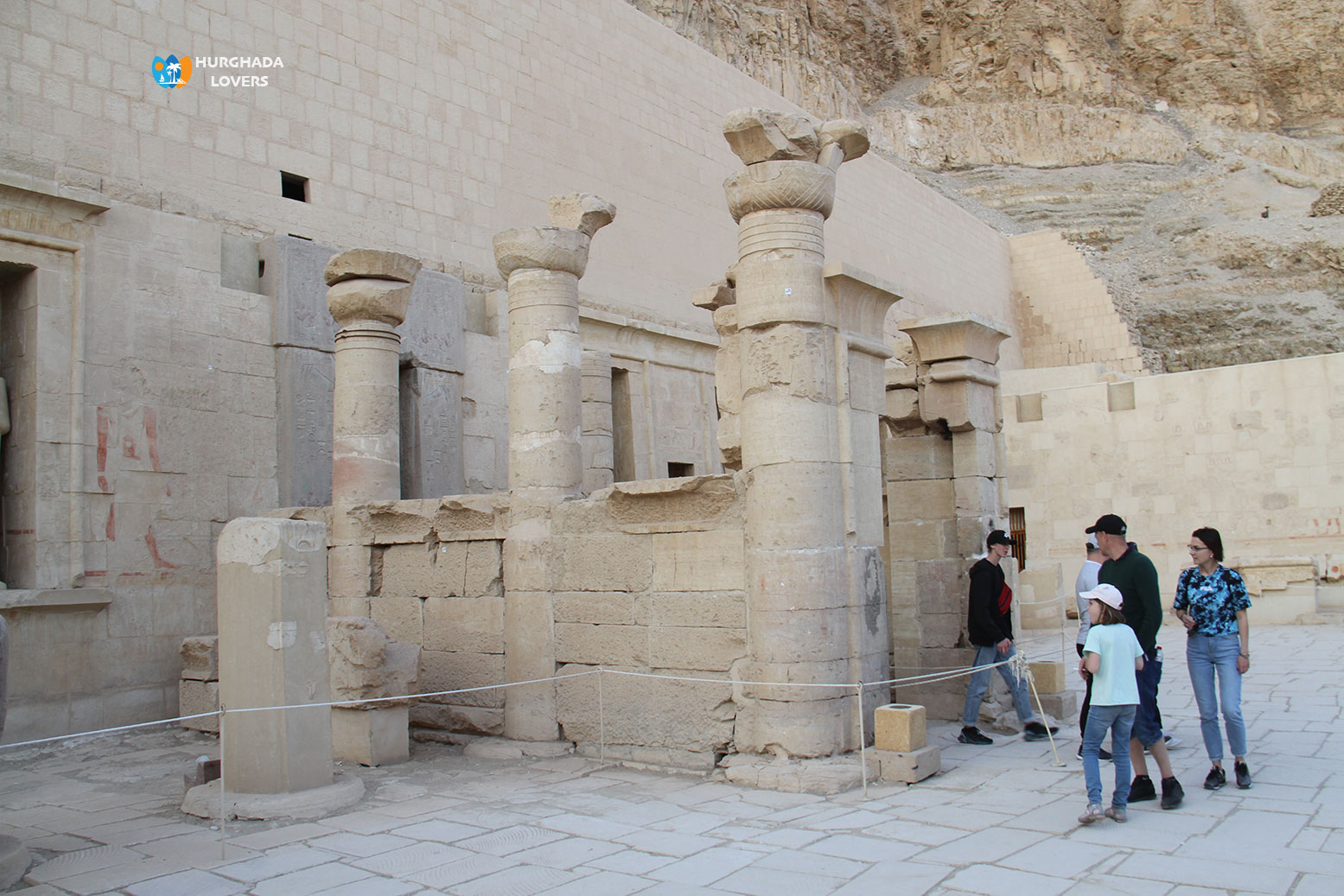
Chambers of Mortuary Temple of Hatshepsut:
main frame chamber:
It contains two square columns, then an iwan that directs you to 4 small structures and Pharaonic drawings on the ceiling of the hall representing the stars in the sky in unique colors to reveal to us the secrets of the zodiac signs of the Pharaohs and show us the extent of the development of Astronomy in ancient Egypt within the Ancient Egyptian science.
In addition to Pharaonic engravings of Queen Hatshepsut and King Thutmose III, son of King Thutmose II, as they offer sacrifices to the goddess Hathor to reveal to us the religious rituals in the Pharaonic civilization..
Then you head to the outer structure, you will find drawings of Queen Hatshepsut offering sacrifices to the sacred cow of the Pharaohs, “the Cow of Hathu,” while she is on the sacred boat, “The Book of the Heavenly Cow”, in addition to drawings of Hathor’s son, “Akhy,” standing in front of the queen, shaking the Pharaonic sistrum to reveal to us the secrets of religious life in ancient Egypt..
Now we head to the inner temple with the domed ceiling, you will find drawings of Queen Hatshepsut suckling from the breast of the cow Hathor and the god Amun standing in front of the head of the queen, then engravings of the goddess Hathor and the god Amun raising the sign of life “Ankh” to the nose of Queen Hatshepsut to reveal to us the secrets of the ancient Egyptian religion..
When you return to the central courtyard and then head down the slope to reach the third floor, you will find the Tomb Queen Neferu II – TT319 “The Theban Tomb” of the Eleventh Dynasty of Egypt of the Middle Kingdom of Egypt, where King Mentuhotep II built a special royal tomb for his wife, Queen Neferu II, in his own funerary Mortuary temple of Mentuhotep II in Deir el-Bahari, adjacent to the temple of Queen Hatshepsut.
The tomb and the pharaonic Ancient Egyptian Coffins chamber were discovered in 1924 and 1925 by Egyptology and archaeologists from The Metropolitan Museum of Art in New York, USA..
When you reach the upper courtyard of Hatshepsut’s temple, you will find a front row of 22 columns on which statues of Queen Hatshepsut in the form of the God Osiris were supported.
However, King Thutmose III transformed them into square columns, in addition to an opposite row of 16-sided columns.
Unfortunately, they were completely destroyed and have become remains until the present time, revealing to us the secrets of sculpture in ancient Egypt..
When you exit the gate made of granite, the most famous of the Ancient Egyptian Metallurgy, on which are the pharaonic Egyptian Cartouche of King Thutmose III, you will find a large courtyard or hall with the remains of two rows of columns, but they are largely dilapidated, in addition to a group of niches..
We now start to go out to the right and enter from a door in the north-eastern direction to reach a small room in which there were three 16-sided columns, where you will find Pharaonic engravings of Queen Hatshepsut standing between the gods Horakhty and Amun, and other drawings on the back wall of Amun, but it is not clear due to the conditions of erosion and climate over time..
Altar Room:
In the middle of the room is a large limestone altar dedicated to the God Horus, in addition to a small funerary temple dedicated to the worship of Queen Hatshepsut’s ancestors..
After finishing the altar room, we head west through a door facing the room of the god Amun or the northwestern room of the aging, where we find Pharaonic drawings of Queen Hatshepsut offering two boats to the God Min and the god Amun, but the engravings have deteriorated greatly, including engravings of King Thutmose III.
The Funerary Temple Of King Thutmose III next to the temple of Hatshepsut in addition to the Tomb of King Thutmose III | KV34 in the tombs of the Valley of the Kings“.
There are rooms on the southern side of the upper canal, but they are very dilapidated. There are Pharaonic engravings of sacrifices, in addition to engravings of a procession of servants preparing Food in ancient Egypt and Funerary Equipment furniture as a type of offerings..
Then we head southwest and find a door that directs you to a room for the god Amun-Ra. You will find engravings from the temple of Queen Hatshepsut offering sacrifices to the god Min and the god Amun-God Ra.
When you head to the second temple, you will find niches in the western wall and pharaonic engravings of Queen Hatshepsut and kings offering sacrifices to the god as was believed in ancient times..
The entrance to the great temple is designed in the form of a door made of granite in front of which is a portico from the Ptolemaic Kingdom era, the beginning of the reign of King Ptolemy I.
Inside the temple you will find 3 rooms, where you will find on the southern wall engravings of the temple garden and on the opposite wall engravings of Queen Hatshepsut.
she has the Tomb of Queen Hatshepsut | KV60 in the Valley of the Kings and King Thutmose III and Princess Neferure presenting to the boat standing behind the boat King Thutmose I (she has the Tomb of King Thutmose I + Queen Hatshepsut | KV20 in the tomb of the Valley of the Kings) and Queen Ahmose and Princess Betneferu.
The Royal Cache of Deir el-Bahri was discovered 110 yards south of the Temple of Hatshepsut in 1881 AD, containing a large group of royal pharaoh Mummy, in addition to a mass tomb containing 163 mummies of priests in 1891 AD, located north of the lower courtyard of the Temple of Queen Hatshepsut..
A huge coffin containing coffin texts was discovered near the well of Queen Hatshepsut, reaching a height of 10 feet, and is still in the burial chamber..
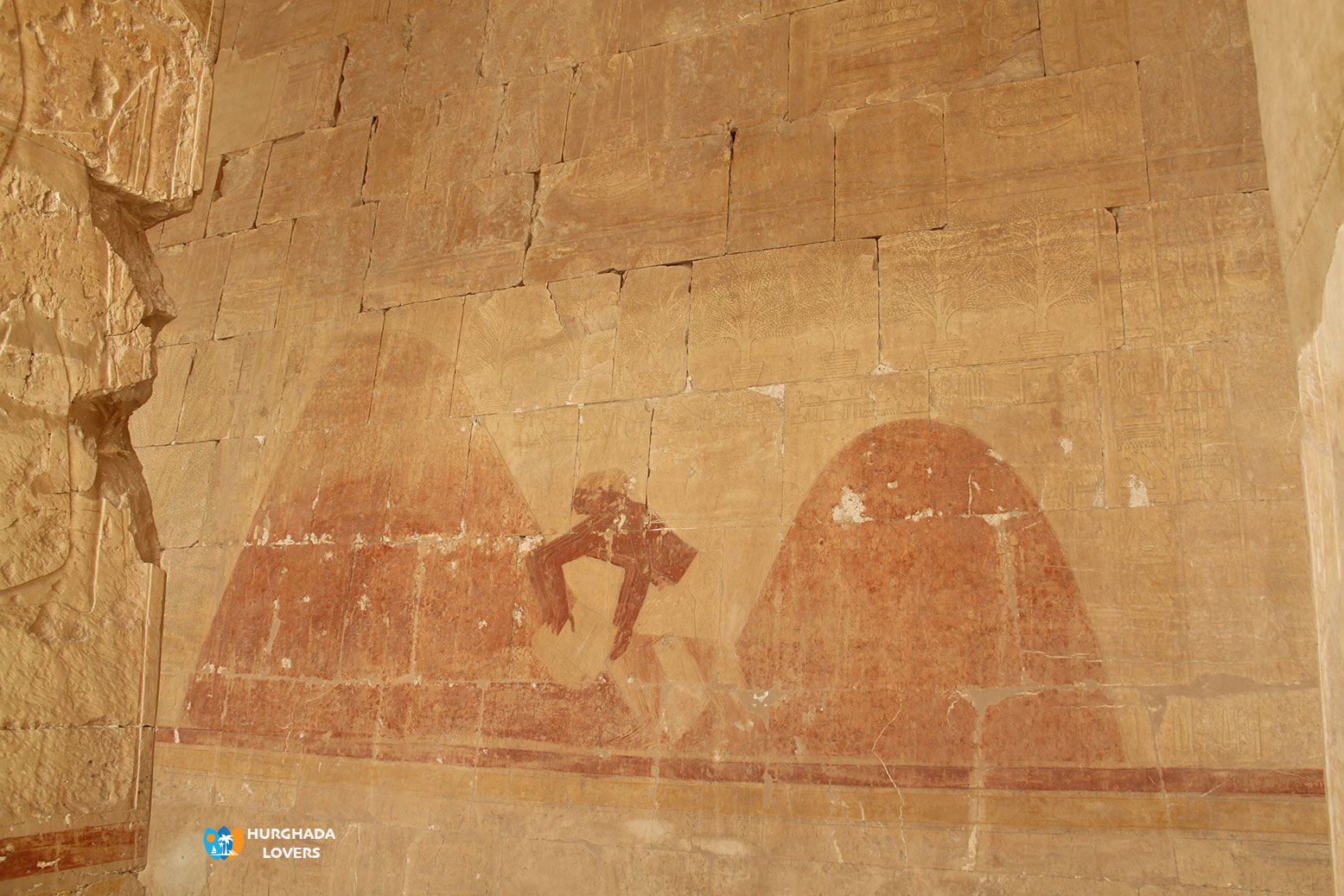
Famous Pharaonic drawings and engravings in Hatshepsut Temple:
- A legendary story that explains that Queen Hatshepsut is not the legitimate daughter of her father, but rather the daughter of the god Amun-Ra who had intercourse with Queen Ahmose, as was believed in ancient times by the Pharaohs, to reveal to us the social aspect of ancient Egypt..
- A pharaonic inscription of the sea voyage sent by Queen Hatshepsut to present-day Somalia to bring goods of incense and spices, revealing to us the secrets of Trade in Ancient Egypt.
- Engravings explaining how the Pharaohs’ Obelisks were transported from Aswan to Luxor.
- The engravings of the balcony system designed by the Pharaonic engineer Senmut, who is considered one of the most famous Pharaonic engineers and who planned the entire Hatshepsut Temple and was close to Queen Hatshepsut, reveal to us the secrets of the art of drawing in ancient Egypt..
Funerary temples:
Temples appeared in various regions north and south of Egypt, even Nubia, as in the Geography of ancient Egypt, and were dedicated to the worship of the gods.
The use of the temple surrounded by columns became widespread, and the columns inspired by the shape of the palm tree became numerous. Among the most famous funerary temples found in that era is the funerary Mortuary Temple of Amenhotep III in Deir el-Bahari, which was built by King Amenhotep III.
King Amenhotep III has the Temple of Amenhotep III in El Kab, the The Tomb of Amenhotep III | KV22 / WV22 in the Valley of the Kings. It is characterized by two surfaces on top of each other, topped by a pyramidal structure..
There is the funerary temple of Amenhotep III near the Hawara Pyramid in Fayoum, which is characterized by a very large number of interconnected rooms.
The Greeks called it the “Labyrinth” or “Labyrinth.” Herodotus (the great Greek historian) said about it that it surpasses the greatness of The Secrets of Pyramid Construction.
Funerary temples were for funeral rituals and priests, and their purpose was not worship. Funeral rituals for kings and princes were performed in them, and their biographies, upbringings, and royal lineage were written in them without mentioning their achievements.
The most famous of them in the Middle Kingdom are the funerary temple tombs in the Beni Hasan Tombs area in Minya, which were built in the Middle Kingdom around The Pyramids of Giza in Cairo..
Queen Maatkare Hatshepsut and Queen Hatshepsut?
The third king of the Eighteenth Dynasty, King Thutmose I, married his sister Ahmose, who bore him three sons, including Queen Hatshepsut and her brother and husband, King Thutmose II.:
Hatshepsut and another son, Prince Thutmose II. As soon as he became king, Prince Thutmose followed the prevailing custom and married his sister Hatshepsut, who only bore daughters. He had another wife, Isis, of unknown origin, who bore him a son, King Thutmose III, who married Queen Merytre-Hatshepsut.
After his death after a reign of no more than six years, Prince Thutmose III was a young child and unable to rule, and not everyone in Thebes was prepared to see him as heir to the throne.
It was the royal daughter and royal wife Hatshepsut who was recognized for her rights, and she was crowned as soon as possible after her husband’s death and at the same time took on her titles as queen,
Her Horus name is Wesret-Kau, meaning powerful of spirits. Her Nabati name is Adjet-Renpet, meaning flourishing of years. Her name is Horus the Golden, Netre Khau, meaning sacred of manifestations..
They used her royal name more than her birth name which reads Maat Kare on the monuments..
She used to serve her ambition with theoretical skill that the clergy used during the days of the ancient Egyptian pharaonic kingdom “Old Kingdom of Egypt“, starting with the rule of King Djoser of the Third Dynasty of Egypt, and she tried to suggest that her father, King Thutmose I, had chosen her to rule, but this was not enough..
On the walls of the Holy of Holies chamber, the sacred story is re-enacted: Amun-Ra, king of the gods, calls upon all the gods of the Great Ennead to be given the kingdom of Egypt.
He takes the form of the ruling king Thutmose I and enters upon the queen at night, and Hatshepsut is.
The gods took care of the queen mother, the child in the form of God Khnum in turn on a wheel: this god and the God Heqet came to the aid of Queen Ahmose, and the sacred cow nursed her with her milk. Only atheists would object to her law protected by the gods..
Let us be sure that some of these objectors would have demonstrated against her if the queen had not gathered around her the great men of state and entrusted them with the major tasks and works of the state: Hapu-Seneb, the first priest of Amun, Djehuty-Sekhe, and Mennakht, the overseer of works..
He led the operations of cutting stones, transporting and erecting granite obelisks, constructing the sacred boat, managing the delicate goldsmithing and ivory works, and supervising the construction of the shrines to reveal to us the secrets of Industry in ancient Egypt.
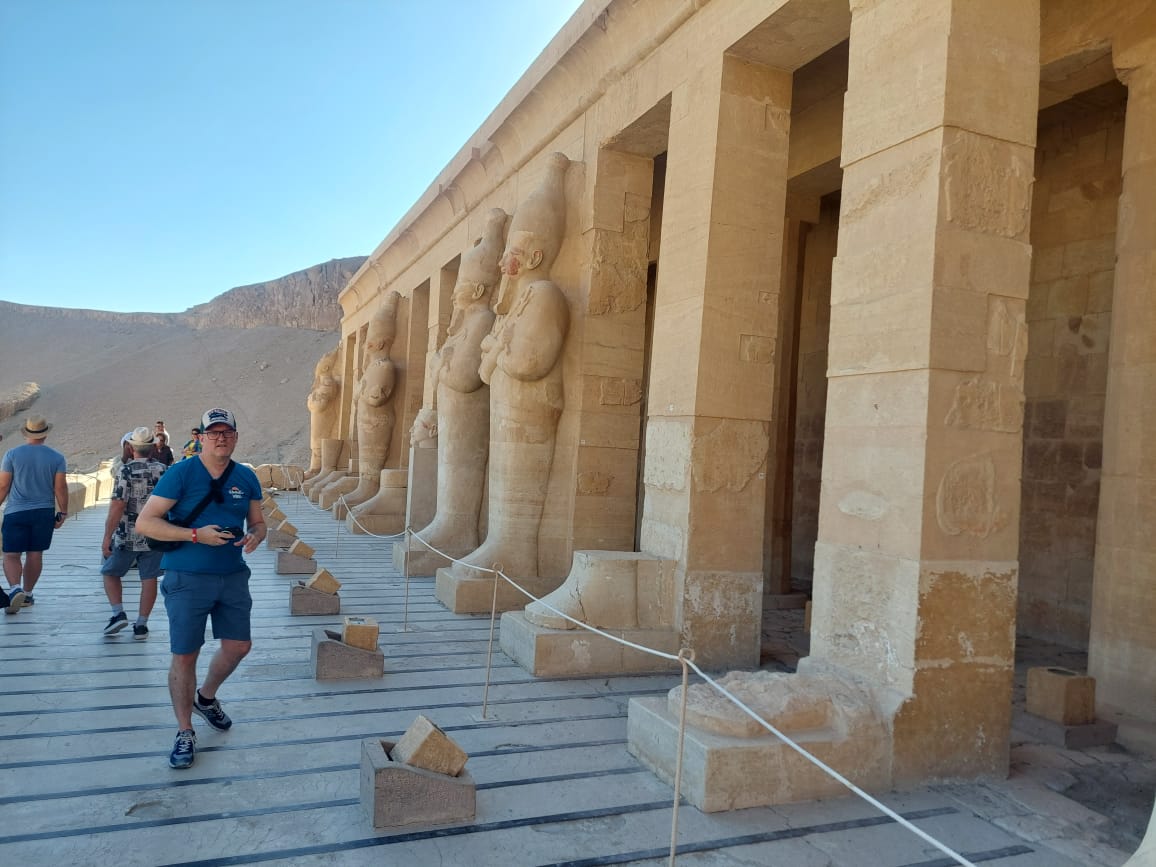
Queen Hatshepsut’s relationship with Senmut Facts?
Among those surrounding the queen was a dangerous figure, the supervisor of the supervisors of the works and the royal advisor, the engineer Senmut..
The names of Senmut and the queen are mentioned together on many monuments, for example, on a rock in Aswan, on a rock shrine and on the foundations of the shrine of the goddess Hathor in Deir el-Bahari. We did not see them as a king and one of his subjects, but rather they are closer to a person of the same social rank to reveal to us the facts of the pharaonic political pyramid. Perhaps we dare to say that they are like a couple..
A view of Senmut carved in a niche in the shrine of the goddess Hathor. Senmut was the foster brother of the so-called father of Hatshepsut, and then of her daughter Princess Neferure. This trust, granted over the years, led him to carve several magnificent statues of himself with his stepdaughter..
Statue No. 2291 in the Berlin Museum belongs to the type of statues we call block statues. We will die limping, sitting cross-legged, raising his knees up to his chin, while the body and its limbs are covered by a woven cloak from which the head of the royal child protrudes below the head of the nurturing father..
The Egyptian Museum “Museums in Cairo” in Tahrir Square holds another statue of Senmut and the little girl, which was found by Legrand, an expert in Egyptian art.
Senmut, who has his large hands around the child’s slender body, has a tender and natural figure, and the child is placing her finger on the chin. These statues were dedicated to him by the queen, and we may guess that there was a more intimate relationship between him and the queen..
By his exceptional luck he obtained permission to carve his tomb in a place adjacent to the Great Temple. At the entrance to one of the chambers, we find a sketch that also indicates the privacy of his relationship with the queen. The tomb, on the other hand, was not completed, and Senmut was buried among the dignitaries of the court in the tombs of the nobles in Luxor “The Pharaonic Tombs from Thebes” in a poor state today (No. 71 in Qurna), and we are surprised by the presence of some Aegean offering bearers.
Temple of Hatshepsut Historical facts for Kids:
- Hatshepsut’s mortuary temple was built directly opposite the Nile River in 1473–1458 BC in the Deir el-Bahari area adjacent to the Valley of the Kings tombs on the western side of Luxor..
- The most important feature of the Temple of Queen Hatshepsut is the statues of the god of the dead, Osiris, on the third level of the Temple of Hatshepsut..
- The purpose of building the temple was to sanctify Queen Hatshepsut after her death, in addition to the worship of King Thutmose I and the religious beliefs and symbols in the ancient Egyptian Pharaonic civilization, namely Hathor, Anubis, and Ra-Horakhty..
- The temple contains an altar room for slaughtering cows in sanctification of the worship of the solar symbol Horakhty. The room has no roof and from it you can see Mount Qurna around you. A wonderful and amazing scene..
- Hatshepsut’s temple was built by excavating inside the Deir el-Bahari mountain, and the largest part was built outside..
- The temple was subjected to many means of destruction by the pharaohs throughout history, but it still retains its basic architectural components..
- The temple is designed to shine with the sun on December 21 or 22 of each year..
- The temple was completely restored in 1990 by the Polish Academy of Sciences..
Hatshepsut Temple from inside / map:
- entrance
- The first courtyard
- Sphinx Street No. 2 Sphinx statue of the queen“
- Ascend to the second level via the staircase..
- The columns of the obelisks were destroyed and no longer exist.“
- Pharaonic inscription on the walls “Hunting, show scenes“
- Second courtyard
- In the eastern direction, the Nativity pole
- Anubis Chapel
- In the southwest direction is the inscription of the Punt expedition..
- In the southwest direction, the Temple of Hathor.
- Climb to the third level via a step ladder..
- Two systems for falcons
- The third courtyard.
- Two rows of columns “statues of the god of the dead Osiris“
- Entrance to Queen Hatshepsut’s open courtyard.
- Amun Symbol Sanctuary.
- Altar room right direction.
- Right direction solar worship room.
- Left side royal worship room.
- Wall of Hatshepsut Temple.
- There is a small room in Hatsjepsoet in Luxor Egypte

Why is Hatshepsut Temple so important?
Because it tells us the secrets of the life of Queen Hatshepsut, one of the queens of the Eighteenth Dynasty, and the secret of her relationship with Semnut, and it is considered one of the most important funerary temples in the ancient Egyptian civilization..
What makes Hatshepsut Temple special?
It tells us the secrets of the ancient Egyptians and their daily life, such as agriculture, industry, trade, slaughtering livestock, and more..
Unique and ingenious architectural design among the mountains.
Why was Hatshepsut’s temple destroyed?
King Thutmose III destroyed large parts of the temple in revenge for Queen Hatshepsut after her death. Parts of Queen Hatshepsut’s statues were assembled in the form of the Sphinx, which is currently located in front of the temple..

Cartridges and names of the pharaohs were found inside the temple of Queen Hatshepsut, and they are::
- King Ahmose I
- King Thutmose I
- King Seti I of the Nineteenth Dynasty of Egypt
- King Ramses II
- King Ramesses IX of the Twentieth Egyptian Dynasty in The Ramesside Period era
- King Ramses III
- King Thutmose III
Hatshepsut Mortuary Temple Address:
Deir el-Bahari, Luxor, Egypt.
Hatshepsut Temple working hours:
Every day from 06:00 AM to 05:00 PM.
Hatshepsut Temple Entrance Ticket Prices Starting November 2024:
Adults = 440 Egyptian pound..
Student/Children 5-10 years= 220 Egyptian pound.
Note: Facts and secrets of the history will be added soon…
Hurghada Excursions Lovers, Best Travel Agency in Hurghada to provide daily tours to visit the Tourist attractions of Luxor by Hurghada to Luxor Tours and Hurghada to Pyramids Trips. Book online when you come to Hurghada, El Gouna, Sahl Hashish, Makadi Bay, Soma Bay, Egypt Tours Packages.
